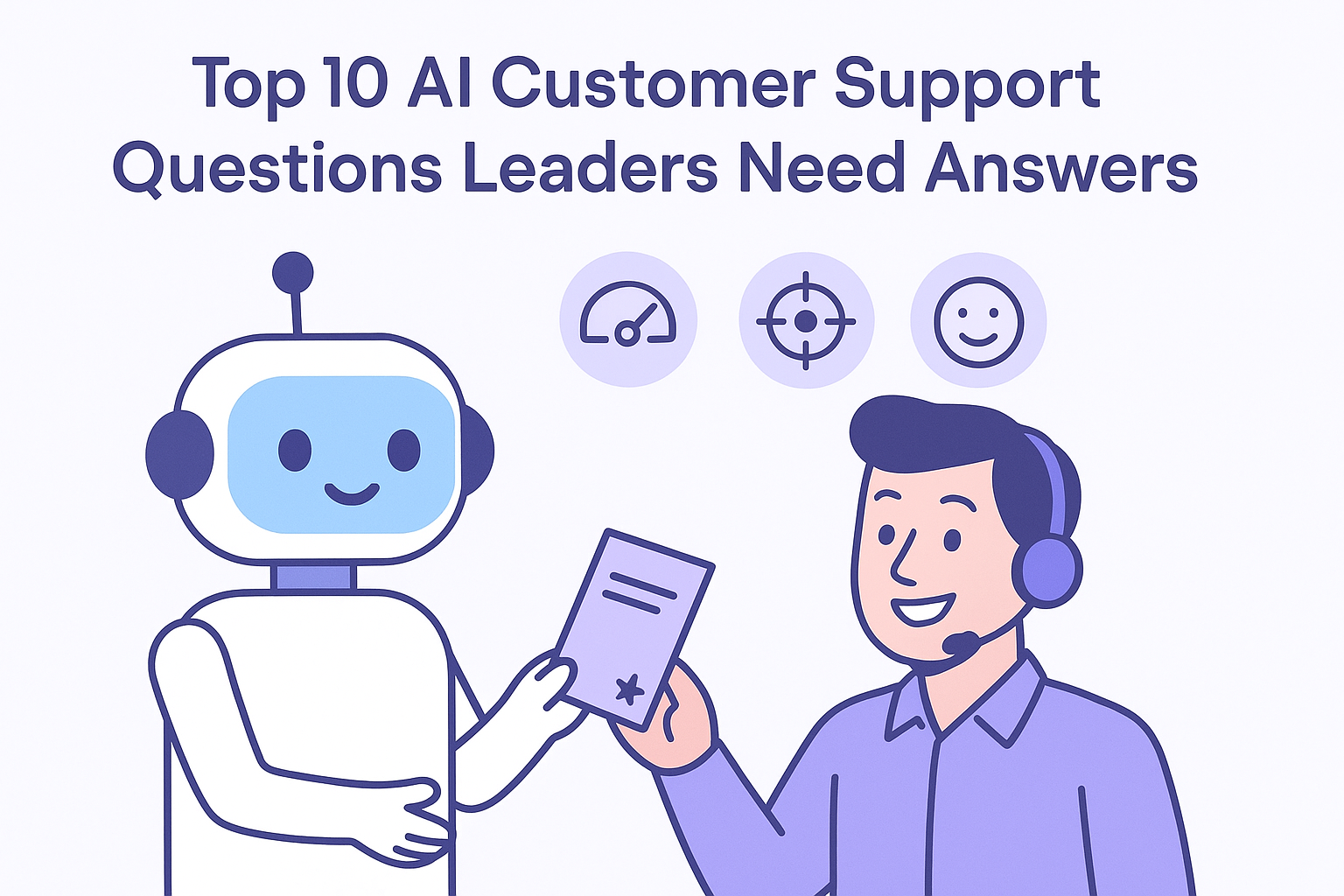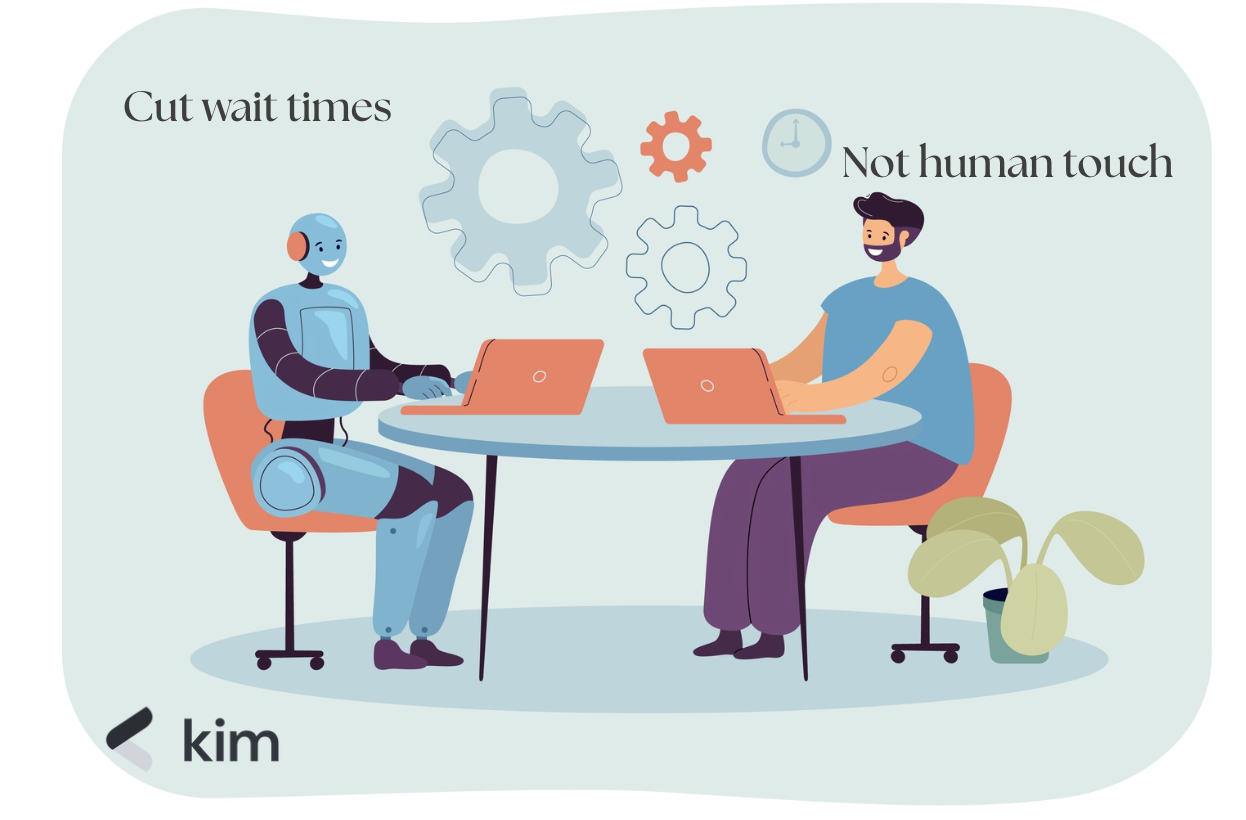Top 10 Questions About AI in Customer Support Every Business Leader Must Know in 2025
If you’ve ever been stuck waiting on hold, repeating yourself to different agents, or arguing with a chatbot that just doesn’t get it, you know the frustration.
That pain is exactly why companies in 2025 are turning to AI in customer support. Done right, it makes service faster, smarter, and more human. But leaders still ask the same big questions:
1) Will AI really cut costs?
2) Can it match our brand’s tone?
3) What if it makes mistakes?
Let’s answer the top 10 questions businesses are asking about AI-powered customer service today, and show how you can implement it successfully.

1. Will AI replace human agents?
The problem: Some leaders fear AI will completely replace humans, leaving customer support cold and impersonal.
The solution: AI doesn’t replace humans, it enhances their work. AI handles repetitive, high-volume tasks while humans focus on:
- Empathy in sensitive situations
- Conflict resolution
- Creative problem-solving
Salesforce reduced its customer support workforce by 4,000 employees, replacing them with AI agents. Despite this significant reduction, customer satisfaction scores remained stable, demonstrating that AI can handle a substantial portion of support tasks without compromising service quality.
Pro Tip: Start with AI automating FAQs, leaving complex tickets for humans.
2. How much money can AI save in support?
The problem: Leaders want to know if AI is worth the investment.
The solution: Businesses using AI helpdesk software typically see:
- 30% reduction in operational costs
- 40% faster response times
- About $3.50 ROI for every $1 invested
Lyft partnered with Anthropic to introduce AI tools for improving its customer care operations. This integration reduced average customer service resolution time by 87%, handling thousands of requests daily, leading to significant cost savings.
Pro Tip: Track agent hours saved and response times to measure real ROI.
3. What can AI actually handle?
The problem: Companies worry AI will mishandle sensitive customer queries.
The solution: AI excels at:
- FAQs (returns, shipping, password resets)
- Ticket triage and routing
- Sentiment analysis (identifying frustrated vs happy customers)
- Predictive alerts (spotting issues before they escalate)
Pro Tip: Keep humans for emotionally charged or complex issues. AI + human hybrid works best.
4. Can AI sound like my brand’s voice?
The problem: A robotic or off-brand tone can hurt customer trust.
The solution: Modern AI can:
- Be trained on your tone, vocabulary, and past conversations
- Mirror your voice consistently across chat, email, and social
- Stay within guardrails to avoid off-brand replies
Motel Rocks, a fashion retailer, faced challenges in managing a high volume of customer inquiries while maintaining its brand voice. By implementing AI, they were able to provide consistent and personalized responses, enhancing customer satisfaction.

Pro Tip: Review AI-generated messages regularly to maintain consistency across channels.
5. How accurate is AI today?
The problem: Concerns about AI giving wrong answers or frustrating customers.
The solution: By 2025, AI-powered customer support achieves over 90% accuracy on routine queries.
Pro Tip: Accuracy depends on a clean, updated knowledge base. Audit your FAQs regularly.
6. Will customers actually accept AI?
The problem: Companies worry about losing human touch or trust.
The solution: Customers are open to AI, 67% of consumers in 2025 are comfortable using AI, as long as human support is available.
Pro Tip: Always provide an easy option to escalate to a human agent.
7. What about data privacy and security?
The problem: Leaders fear exposing sensitive data.
The solution: Choose AI support systems with:
- Enterprise-grade encryption
- Compliance certifications (GDPR, HIPAA where relevant)
- Clear data use policies
Pro Tip: Don’t rush AI deployment; security is non-negotiable.
8. How fast can I see ROI?
The problem: Leaders want results quickly.
The solution: For mid-sized businesses, ROI typically appears in 8–12 months. Start with:
- Automating your top 20 FAQs
- Tracking savings in response time + agent hours
- Scaling after measurable results
Pro Tip: Use dashboards to track KPIs like CSAT, first response time, and escalation rates.
Want to learn more about it:- Here's our take on it
9. What are the risks of AI in support?
The problem: AI adoption can fail if done too quickly.
The solution: Key risks and mitigation strategies:
- Over-automation: Customers feel trapped → maintain human escalation paths
- Inaccurate responses: Outdated training data → update knowledge base regularly
- Team resistance: Agents may feel threatened → position AI as a productivity tool
- Security gaps: Poor design → invest in enterprise-grade security
Pro Tip: Implement AI gradually and track agent adoption.
10. How do I get started without disrupting my team?
The problem: AI rollout can overwhelm employees or break processes.
The solution: Step-by-step approach:
- Automate repetitive FAQs first
- Keep humans in the loop with clear escalation paths
- Train AI on updated knowledge and brand tone
- Track KPIs: response time, CSAT, escalation rates
Pro Tip: Start small, measure results, and expand incrementally.
Final Thoughts
AI in customer support isn’t just about cost savings or efficiency, it’s about:
- Reducing agent burnout so they focus on meaningful work
- Empowering teams to deliver empathy and creativity
- Delighting customers with faster, more personal resolutions
3 Key Takeaways for Leaders:
- AI won’t replace humans, it replaces repetitive work.
- Hybrid AI + human models deliver the best satisfaction and ROI.
- The winners in 2025 scale humanity, not strip it out.
Ready to See Where AI Fits in Your Support?
